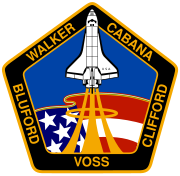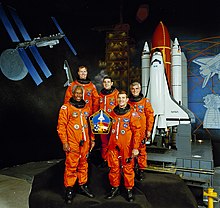 Launch of Discovery for a Department of Defense (DoD) mission | |
| Names | Space Transportation System-53 |
|---|---|
| Mission type | DoD satellite deployment |
| Operator | NASA |
| COSPAR ID | 1992-086A |
| SATCAT no. | 22259 |
| Mission duration | 7 days, 7 hours, 19 minutes, 17 seconds |
| Distance travelled | 4,883,840 km (3,034,680 mi) |
| Orbits completed | 116 |
| Spacecraft properties | |
| Spacecraft | Space Shuttle Discovery |
| Launch mass | 110,655 kg (243,953 lb) |
| Landing mass | 87,565 kg (193,048 lb) |
| Payload mass | 11,860 kg (26,150 lb) |
| Crew | |
| Crew size | 5 |
| Members | |
| Start of mission | |
| Launch date | December 2, 1992, 13:24:00 UTC (8:24 am EST) |
| Launch site | Kennedy, LC-39A |
| Contractor | Rockwell International |
| End of mission | |
| Landing date | December 9, 1992, 20:43:17 UTC (12:43:47 am PST) |
| Landing site | Edwards, Runway 22 |
| Orbital parameters | |
| Reference system | Geocentric orbit |
| Regime | Low Earth orbit |
| Perigee altitude | 365 km (227 mi) |
| Apogee altitude | 376 km (234 mi) |
| Inclination | 57.00° |
| Period | 92.00 minutes |
| Instruments | |
| |
 STS-53 mission patch  Back: Walker, Cabana and Clifford Front: Bluford and Voss | |
STS-53 was a NASA Space Shuttle Discovery mission in support of the United States Department of Defense (DoD). It was Discovery's 15th flight. The mission was launched on December 2, 1992, from Kennedy Space Center, Florida. This was also the last mission to have been operated via MCR-2 in JSC. Afterwards the room was restored entirely to its Apollo era appearance.